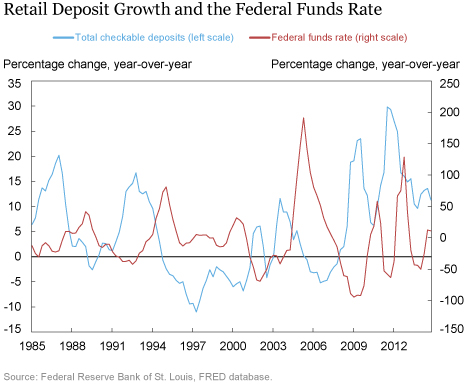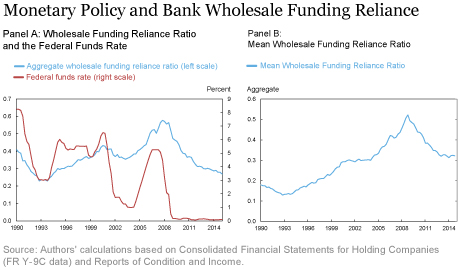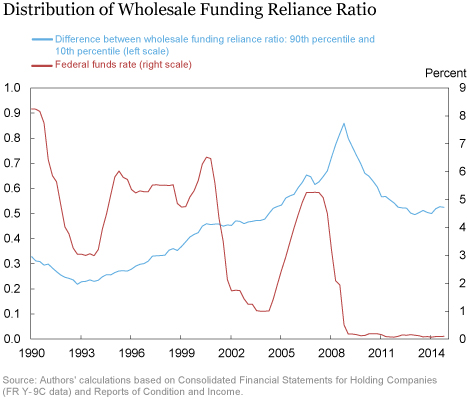The recent financial crisis clearly revealed that the reliance of banks on short-term wholesale funding critically increased their funding liquidity risks; during market disruptions, it becomes more likely that banks will be unable to roll over those funds and will hence be forced to fire-sell illiquid assets and possibly contract lending. To limit such risk, the Basel Committee on Banking Supervision (BCBS) has introduced new liquidity regulations such as the Liquidity Coverage Ratio (LCR) and the Net Stable Funding Ratio (NSFR) to prevent excessive reliance on runnable funding in the banking sector. But what forces contributed to the banking sector’s reliance upon wholesale funding and how will the new liquidity regulations interact with monetary policy? Drawing on our recent Staff Report, we argue that monetary tightening by central banks, perhaps intended to contain credit booms, can lead banks to increase their reliance upon wholesale funding and contribute to systemic imbalances. Importantly, we explain how the new liquidity regulations adopted since the crisis would help mitigate any such increase in systemic risk.
Substituting Funding to Mitigate the Policy Impact
Banks typically fund themselves from two sources, retail deposits and wholesale funding. Retail (or “core”) deposits are made by a bank’s traditional customer base in its local market and are used by depositors primarily for saving or transactions. By comparison, wholesale funding is supplied by institutional investors (examples include large certificates of deposit, foreign or brokered deposits, and repo funding). Retail deposits are cheaper for the bank and “stickier” (less prone to run). However, because the supply of retail deposits is relatively insensitive to interest rates (price inelastic), banks tend to rely on wholesale funding when they decide to expand lending.
When a central bank tightens monetary policy, that usually reduces retail deposits in the banking sector due to decreased money demand or a decrease in central bank reserves that limits the creation of reservable deposits (that is, deposits that require central bank reserves), or both. The chart below plots growth in total checkable deposits at U.S. banks and the federal funds rate; the two series are negatively correlated so that when the fed funds rate rises, retail deposits tend to decrease.
As retail deposits decline, banks tend to substitute wholesale funding in order to maintain their lending. This substitution, which tends to mitigate the impact of the policy tightening on lending, also increases the reliance of banks on wholesale funding. Of course, banks face varying degrees of financial frictions that can limit their access to wholesale funding. And banks that face fewer frictions—usually larger banks already more reliant on wholesale funding—are more capable of this type of substitution and thus increase their wholesale funding borrowing more. As a result, monetary tightening could lead to an increased overall reliance and more concentration of wholesale funding among large “systemic” banks.
In the chart below, panel A reveals that reliance on wholesale funding in the banking sector, as measured by the ratio of wholesale funding to retail deposits (“wholesale funding reliance ratio” hereafter), tends to increase with the fed funds rate. Note that reliance on wholesale funding trended upward in the period before the recent financial crisis, but fell sharply after. Panel B reports the average wholesale funding reliance ratio based on bank-level wholesale funding reliance ratios. Arithmetically, this unweighted average puts less weight on larger banks (which tend to have high wholesale funding reliance ratios) and more weight on smaller banks (which tend to have low wholesale funding reliance ratios) than in panel A. Comparing the panels indicates that the reliance of large banks on wholesale funding is both higher, and more volatile.
The chart below shows how tighter monetary policy tends to concentrate wholesale funding among banks with a greater reliance upon wholesale funding to begin with. Plotted is the difference between the 90th percentile and 10th percentile in the distribution of wholesale funding reliance ratios, along with the fed funds rate. The two series tend to move together indicating that concentration in wholesale funding reliance ratios increases with tighter policy.
Implications
This funding substitution in response to monetary policy has several implications. First, it suggests that monetary tightening could increase systemic risk if banks actively try to reverse the effects of the tightening by substituting wholesale funding (with greater funding liquidity risks) for retail deposits. Further, our cross-sectional results in the chart above imply that this risk would apply more to large, potentially systemically important banks that are already more reliant on wholesale funds. This is contrary to the conventional wisdom that monetary tightening could mitigate systemic imbalances by slowing down a credit boom. Although that view may be true, our analysis suggests a possible offsetting effect on the liability side: systemic risk might increase (or decrease less than hoped) as banks attempt to unwind the effects of the tightening. Importantly, the new liquidity regulations would help mitigate any increase in systemic risk through this channel by increasing the implicit cost of replacing retail deposits with wholesale funding.
Disclaimer
The views expressed in this post are those of the authors and do not necessarily reflect the position of the Federal Reserve Bank of New York or the Federal Reserve System. Any errors or omissions are the responsibility of the authors.

Dong Beom Choi is an economist in the Federal Reserve Bank of New York’s Research and Statistics Group.
Hyun-Soo Choi is an assistant professor of finance at Singapore Management University.













 RSS Feed
RSS Feed Follow Liberty Street Economics
Follow Liberty Street Economics